You see them in shifting clouds and long skeins flying over the land. And it’s a real challenge to scan the thousands of greater white-fronted geese and greylag geese to try and spot the occasional lonely lesser white-fronted goose – smaller and characterized by a yellow ring around the eye – or the red-breasted goose with its beautiful markings. But the government is not happy about the geese. Due to exceptionally successful policy, their numbers have exploded in recent years. As a result, the populations now need to be controlled to prevent damage to farmland. The state favours gassing the geese but the EU opposes the plan: there are several protected species at stake. A response I saw recently suggested that gassing would be the most humane solution. As I type these words, my fingers falter because I realize how dreadful they sound in this context. A few years ago, 4,500 geese were gassed on a Natuurmonumenten reserve on the island of Texel. That is a whole truckful. Greylag, white-fronted, barnacle and bean: geese come in all shapes and sizes. Some species will be spared, if the EU gets its way. So if you’re a goose, it’s good to be the right kind of goose. The wind is changing to the west and temperatures in the north will soon be rising above zero. But there is still a dark cloud hanging over many geese.
Geese
It is winter and the cold air is driving large flocks of geese from northern Europe to the Netherlands. To me, a fantastic sight, especially when a big flock all takes off together.

